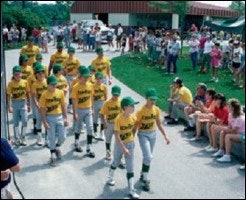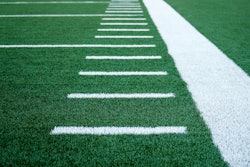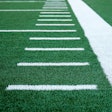Today's Recreational Sports Landscape Is Broader Than Ever, Challenging Sportsplex Operators to Accommodate Diverse Activities Within Limited Space

As a former financier, Mike Weis knows firsthand the importance of asset allocation. That's why in his most recent business venture as operator of Epic Center Inc., a 12-acre indoor/outdoor sports complex in Williamsville, N.Y., Weis has spread his facility's spacial wealth among nine recreational sports activities. "I come from a banking environment, and you don't want to have all your eggs in one basket," says Weis, who launched Epic Center in 1996. "Some sports are hotter than others. Our field hockey and flag football programs have really grown, whereas our 10- and 11-yearold soccer groups have gone down. You try to shelter yourself from ups and downs. That's why we do nine sports."
Weis is fortunate in that his facility has room for activities he hasn't even introduced to it yet, such as sand volleyball (which may begin outdoor play as early as this year) and paintball (which may one day take advantage of the complex's lone wooded acre). That is not to say that Weis, like most sportsplex operators, doesn't make efficient use of his active courts and fields - after all, he accommodates as many as four separate activities on the same playing surface at different times. It's a practice deemed necessary to meet the needs of recreation enthusiasts of varying ages and interests while remaining financially viable.
"A lot of user groups would prefer specialized facilities, because they wouldn't have to deal with a lot of issues, such as being able to get the times that they want at those facilities," says Ken Ballard of Ballard*King & Associates, a recreation facility planning and operations consulting firm in Highlands Ranch, Colo. "But as an operator, you need to have as much flexibility of space - whether it's indoor or outdoor - as you can so that you can adjust the facility for a variety of different uses, as well as ages and abilities."
Sportsplexes have remained a popular means of delivering recreation services for at least a quarter-century, and for good reason. They succeed in attracting large numbers of participants to one location, they centralize facility maintenance and the administration of leagues and tournaments, and they open up revenue streams - such as those from concessions stands, pro shops and game rooms - that stretch beyond mere league entry fees.
They have branched out over the years from the standard cloverleaf groupings of softball diamonds to encompass outdoor fields for soccer and other emerging ball sports, such as lacrosse, rugby and field hockey, often offering both summer and fall leagues. They have headed indoors and brought these sports (yes, even softball) and others with them under the canvas of air-supported domes and the aluminum and steel roofs of prefabricated structures in a move that encourages year-round participation in a variety of sports.
But as the seasons have blurred, so have the game lines regulating many of these sports, particularly those played outdoors. It's not uncommon for soccer games to be staged on abridged pitches in the outfields of softball diamonds or on fields better suited in size for flag football. These are the kinds of compromises that come with maximizing sportsplex usage. "Sometimes, in today's world, we compromise to death," says sportsplex consultant Jim Hilkemeyer, president of Tuscon, Ariz.-based RecTech. "We decide to design a racehorse, and because we try to make it so many things, it ends up being a camel. That happens when we are not careful about cross-designing for multiple use."
Choosing what sports to include in a complex also takes great care, according to Teresa Grills, CEO of GreenPlay LLC, a Broomfield, Colo., consulting firm that conducts feasibility studies for park and recreation agencies, as well as private entities. "The first thing we do is figure out what's going to fly in the community, and then see that the facility can accommodate as much use as it can," says Grills. "It's important that you don't duplicate services, so that you get the highest percentage of use from the community."
Grills recommends combining an analysis of current services provided by the local recreation department, YMCA, churches and other organizations with U.S. census information and national participation trend data compiled by SGMA International, the trade association that serves the sporting goods industry. She advocates narrowing the focus by conducting a statistically valid survey of community residents, both adults and children, about the indoor and outdoor activities that interest them. "You can get as specific as you want, depending on what you're trying to put in," she says. "If indoor soccer, lacrosse and inline hockey are not provided publicly in your area, those are the things that make more sense for sportsplex operators."
Once the requested indoor and outdoor activities have been established, several considerations must be taken into account if the sportsplex operator wishes to make efficient use of the facility.
The biggest reason for overlapping more than one activity on any given outdoor field is a lack of alternative green space. "Many of the municipalities are slowly but surely becoming land poor," says Bob Papich, president of the Sportsplex Operators & Developers Association (SODA). "That doesn't allow for a great deal of flexibility."
Still, most experts agree, it pays to think big when possible. A regulation soccer pitch, among the largest of outdoor fields at a maximum 130 by 100 yards, can be easily restriped as one full-size 120-by-54-yard football field. Not so the other way around.
When designs were drawn up for Farmington (N.M.) Family Sports Complex's baseball and softball fields (below), city officials shifted focus from a youth-first facility to one that would be large enough to handle a variety of age groups. "The city wanted to go with the maximum size possible that would fit within the site to accommodate the men's softball super leagues, but also allow the utilization of temporary fencing to bring the outfield in for youths," says architect Ed Bledowski, a principal with DLR Group, which oversaw the project.
A sportsplex with eight diamonds may require 4,000 feet of portable plastic fence, but Bledowski never envisioned installation and removal on a per-event basis. Rather, he saw it as a means of remaining flexible as user demographics change season to season. "If you have a large number of youths that are coming in, you could modify the infield and put a temporary fence in the outfield to accommodate that," he says. "The following season, there might not be a need for that age group anymore, and you could reconfigure the field again to match the needs of the population that you're accommodating."
The Farmington site featured enough space for two cloverleaf clusters of ball fields - one dedicated to softball, the other to baseball. For those facilities forced to accommodate both sports on the same diamond, significant compromises are in order. The arc that delineates the union of a softball field's skinned infield with the outfield grass must be cut deeper into the outfield to make room for baseball's longer base paths. Base anchors must be positioned separately to accommodate both sports, with caps and dirt covering those anchors not in use. Portable pitching mounds constructed of polyurethane - or, in some homemade configurations, wood and synthetic turf - must be available for baseball. Lighting levels must meet the more intense requirements of baseball, and light poles need to be of sufficient height, since baseballs arc higher into the night sky than do softballs. Available in reduced-flight varieties for both sports, the balls themselves can be selected to lessen the impact of permanent outfield fence distances that are otherwise inappropriate for the given sport or its level of competition.
Such compromises don't bother Don Aselin, executive director of SODA and CEO of Sports Park of New York, a 25-year-old outdoor sportsplex in Rochester. To Aselin, getting individuals involved in active recreation is far more important than getting hung up on field dimensions and playing rules. "What we didn't realize until about 15 years ago was that the size of the field doesn't matter at the recreational level," Aselin says. "You can pretty much make the sizes adapt to what you have."
Sports Park includes one regulation football field (overlaying the complex's largest softball diamond), but Aselin also employs three additional 80-by-40-yard fields for football. Two games of youth soccer, or those pitting smaller teams of older players, can be run simultaneously on opposite halves of the same field, he says, and the same goes for sand volleyball. "The participants don't move in as large an area, but they're still moving," says Aselin. "Quite frankly, a lot of times the little kids can't get to the ball on a regulation court. This gets them more involved, and they get to learn the fundamentals of the game very quickly."
Of the seven softball diamonds at Sports Park, three can accommodate baseball. But while these sports carried sportsplexes for many years, recreational participation in them is now in nationwide decline. Sports Park compensates by offering "nickel" leagues in both sports. Games involve three five-person teams: one accounts for the pitcher and four outfielders, the second fills the catcher and four infield positions, and the third takes its turn at bat. All teams rotate after three outs, and the team with the most runs after five innings wins. "It keeps more people interested in the game and playing the game," Aselin says. "It hurts me to go to a town-rec department's field where they play baseball once a week. It's really a waste of space and taxpayers' dollars. There are people who just can't afford to build new things, so why not use what you already have for multiple purposes?"
All of this multipurpose use can wear on natural grass fields, however. Simply put, fields need time to recover, a concept that may weigh heavily on the space-strapped sportsplex operator. Short of leaving a field dormant for an entire season to recuperate, operators can rotate their fields by age group (kids are less taxing on turf than teens and adults) or rotate the orientation of a given field to keep it functional. Wear spots are particularly evident near the goal mouths on soccer and lacrosse fields. "You need to be able to flip your fields in another direction to give those goal mouths a rest," says Ballard, who recommends planning for a square platform, or at least one with extra space outside the playing field's sidelines to accommodate this perpendicular spin. "Any area that's laid out to allow you to change the direction of the field or to shorten it up for another activity is beneficial."
In addition, teams should be encouraged to conduct their warm-up activity in places on the field that aren't likely to exhibit heavy wear - namely the lengthwise thirds of the field that flank its center. Papich believes these measures are particularly important for sportsplexes, which the public rightly holds to a higher maintenance standard than other recreational green space. "The athletic turf is a selling point for most complexes," he says. "It's not supposed to look like a neighborhood park's field that's been heavily used."
Surfaces are also critical to the functionality of indoor sportsplex elements, which may see inline hockey, volleyball and basketball played in one space. Plastic tiles are the popular choice in this setting for maximizing versatility and use. Weis, for example, can remove just a few tiles within his boarded rink (Epic Center also features two indoor synthetic fields) to expose the volleyball stanchion sleeves that he had installed in the floor's substrate. "We pop up the tiles and put the poles in," he says. "It takes about 25 minutes, but that accommodates 16 volleyball teams that we would never have if we didn't use that surface." For basketball, Weis rolls two heavy-duty portable goals onto the tiles, which carry each activity's boundary lines. "Everything's marked," he adds. "Basketball is black, volleyball is yellow and hockey is red." The rink even serves as a makeshift venue for soccer practice. "We do that because our two other venues, at least in January, are maxed out," says Weis.
Epic Center earmarks a 65-by-38-yard synthetic turf field for girls' lacrosse (boys and men are relegated to the boarded area, since they tend to inflict more facility damage, Weis says), field hockey, coed soccer and a variety of practices. A separate 40-by-70-yard field accommodates flag football, as well as youth and adult soccer. "I have three venues, and I do different sports at each one, depending on availability and when people want to play," says Weis.
According to Grills, this is a fairly typical program for today's indoor sportsplexes. "There's a trend right now toward going big, and a lot of them will have at least three or four full-size indoor fields," she says. "What used to be considered big was a rink-sized indoor field, and that was kind of it. Now, to maximize revenues, you typically need to have two, at least." Given its location a dozen miles northeast of downtown Buffalo, the Epic Center succeeds in filling a void for those residents who wish to play soccer (or football, field hockey or lacrosse) regardless of the outside temperature. The success of an indoor sportsplex may well hinge on whether it can supply what the public demands and when.
"If you're a private enterprise, and your municipality or local YMCA doesn't have any indoor facilities and yet they've got a thousand soccer teams, you could do very well for yourself by creating indoor soccer facilities," says Grills. "Especially in colder climates, you get the feeders that come naturally into your facility in the winter." To fill any remaining voids in his programming schedule, Weis will occasionally step outside the sports arena. "I've also rented the facility out to people for product demonstrations," he says. "We've done proms in here. We've done First Communions. You know, we've tried just about everything."
For their facilities to remain viable, sportsplex operators need to be able to fill time and space with as much activity as possible. That means building flexibility into the facility through creative adjustments to traditional infrastructure and programming. "We need it," says Papich. "We need to be flexible in our designs, because that allows us to be more creative."
Sportsplexes may never be highly profitable, investor-driven enterprises, as Hilkemeyer predicted some 17 years ago, but they certainly continue to hold value in the purest sense. "The fact that putting activities together in this fashion is a smarter way to develop a delivery for recreation in most communities remains true," he says.
"Let's face it, in today's society we need to recreate, we need to congregate as groups, and that area must be set aside within a community," Papich says. "Play is important - not only for children, but for adults. Many adults look forward all week to playing softball, flag football, whatever it is. And if bad weather takes place, and they can't do it, they feel bummed out. They got robbed. It's still very important to have places where people can play, and in some cases, sports can be handled better indoors than out."





































